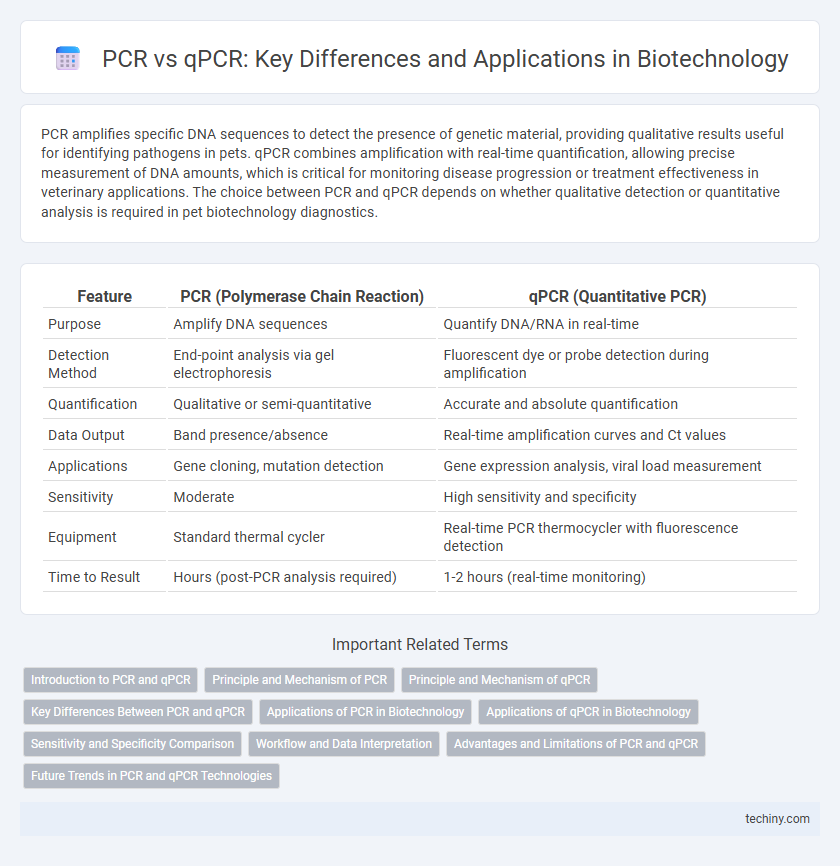PCR amplifies specific DNA sequences to detect the presence of genetic material, providing qualitative results useful for identifying pathogens in pets. qPCR combines amplification with real-time quantification, allowing precise measurement of DNA amounts, which is critical for monitoring disease progression or treatment effectiveness in veterinary applications. The choice between PCR and qPCR depends on whether qualitative detection or quantitative analysis is required in pet biotechnology diagnostics.
Table of Comparison
| Feature | PCR (Polymerase Chain Reaction) | qPCR (Quantitative PCR) |
|---|---|---|
| Purpose | Amplify DNA sequences | Quantify DNA/RNA in real-time |
| Detection Method | End-point analysis via gel electrophoresis | Fluorescent dye or probe detection during amplification |
| Quantification | Qualitative or semi-quantitative | Accurate and absolute quantification |
| Data Output | Band presence/absence | Real-time amplification curves and Ct values |
| Applications | Gene cloning, mutation detection | Gene expression analysis, viral load measurement |
| Sensitivity | Moderate | High sensitivity and specificity |
| Equipment | Standard thermal cycler | Real-time PCR thermocycler with fluorescence detection |
| Time to Result | Hours (post-PCR analysis required) | 1-2 hours (real-time monitoring) |
Introduction to PCR and qPCR
PCR (Polymerase Chain Reaction) is a molecular biology technique used to amplify specific DNA sequences, enabling researchers to generate millions of copies of a target DNA segment from small initial samples. qPCR (quantitative PCR), also known as real-time PCR, builds on traditional PCR by quantifying DNA amplification in real-time using fluorescent markers, allowing for precise measurement of DNA concentration during the exponential phase. Both methods are fundamental in genetic analysis, diagnostics, and biotechnology research, with qPCR providing enhanced sensitivity and quantitative data compared to conventional PCR.
Principle and Mechanism of PCR
Polymerase Chain Reaction (PCR) amplifies specific DNA sequences through repeated cycles of denaturation, annealing, and extension using DNA polymerase, primers, and nucleotides. The denaturation step separates the double-stranded DNA, annealing allows primers to bind to target sequences, and extension synthesizes new DNA strands. This cyclic mechanism exponentially increases target DNA, enabling detailed genetic analysis in biotechnology.
Principle and Mechanism of qPCR
Quantitative PCR (qPCR) amplifies DNA sequences while simultaneously quantifying the amplified products using fluorescent dyes or probes that emit signals proportional to the DNA amount. Unlike conventional PCR, which only provides end-point data, qPCR monitors the amplification process in real-time through cycle-by-cycle fluorescence measurement, enabling precise quantification of initial target DNA. The mechanism involves the DNA polymerase enzyme synthesizing new DNA strands and the fluorescence increase reflecting the accumulation of PCR products during each amplification cycle.
Key Differences Between PCR and qPCR
PCR amplifies DNA fragments through repeated thermal cycling, providing qualitative results by detecting the presence or absence of target sequences. qPCR, or quantitative PCR, uses fluorescent dyes to monitor DNA amplification in real-time, enabling precise quantification of initial DNA concentrations. Key differences include qPCR's ability to measure gene expression levels dynamically, higher sensitivity, and faster data acquisition compared to traditional PCR.
Applications of PCR in Biotechnology
PCR amplifies specific DNA sequences for applications such as cloning, gene expression analysis, and genetic modification in biotechnology. It enables the production of sufficient DNA for sequencing, genotyping, and detection of pathogens in clinical diagnostics. PCR serves as a fundamental tool for creating recombinant DNA molecules and studying genetic variants in research and industrial processes.
Applications of qPCR in Biotechnology
qPCR (quantitative Polymerase Chain Reaction) is extensively used in biotechnology for precise quantification of nucleic acids, enabling real-time monitoring of gene expression, detection of genetic mutations, and viral load analysis. Unlike traditional PCR, qPCR allows high-throughput screening in drug development, biomarker discovery, and pathogen detection with enhanced sensitivity and specificity. Applications in personalized medicine, GMO analysis, and epigenetics research further highlight qPCR's critical role in advancing biotechnological innovations.
Sensitivity and Specificity Comparison
PCR and qPCR differ significantly in sensitivity and specificity, with qPCR offering enhanced detection limits due to real-time fluorescent monitoring of amplicon accumulation, enabling quantification of low-abundance nucleic acids. Sensitivity in qPCR can reach as few as 10 copies of target DNA, surpassing conventional PCR's endpoint analysis, which often lacks the precision needed for low-copy detection. Specificity in qPCR is improved through the use of sequence-specific fluorescent probes, reducing non-specific amplification compared to PCR, which relies primarily on gel electrophoresis for product verification.
Workflow and Data Interpretation
PCR amplifies DNA through cyclical temperature changes enabling exponential replication, while qPCR quantifies DNA in real-time using fluorescent probes during amplification. PCR workflow includes denaturation, annealing, and extension, producing endpoint data analyzed by gel electrophoresis, whereas qPCR integrates amplification and detection in a closed-tube system, providing quantitative data through fluorescence measurement. Data interpretation in PCR is qualitative or semi-quantitative based on band intensity, whereas qPCR delivers precise quantification by measuring the threshold cycle (Ct) values correlating to initial DNA copy numbers.
Advantages and Limitations of PCR and qPCR
PCR offers a rapid and cost-effective method for amplifying DNA, enabling the detection of genetic material in various samples, but it lacks quantitative capabilities and has a higher risk of contamination due to post-amplification handling. qPCR provides real-time monitoring of DNA amplification through fluorescent markers, allowing quantification of nucleic acids with higher sensitivity and specificity, yet it requires more sophisticated equipment and is generally more expensive. While PCR is suitable for qualitative analysis, qPCR is preferred for precise gene expression studies and diagnostic applications requiring quantitative data.
Future Trends in PCR and qPCR Technologies
Emerging advancements in PCR and qPCR technologies emphasize higher sensitivity, faster amplification cycles, and integration with digital platforms for real-time data analysis. Innovations such as nanopore-based detection and microfluidic chip integration are poised to revolutionize point-of-care diagnostics and personalized medicine. Enhanced multiplexing capabilities and AI-driven interpretation algorithms will further optimize accuracy and throughput in genomic and transcriptomic research.
**PCR vs qPCR** Infographic

 techiny.com
techiny.com